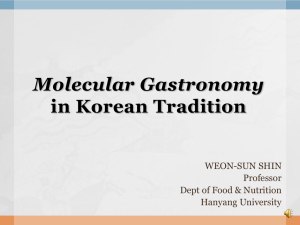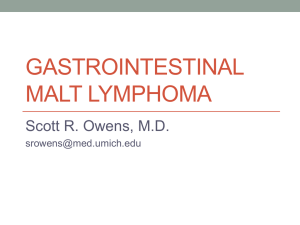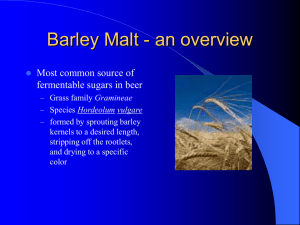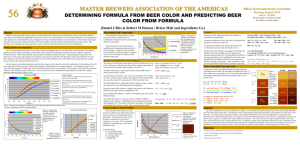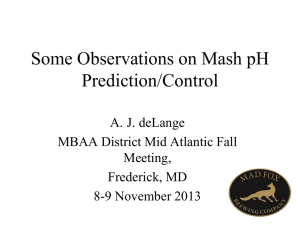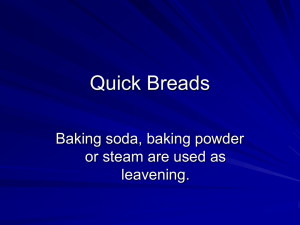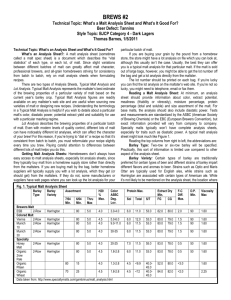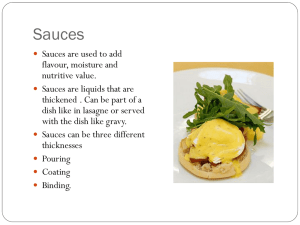Malt in bakery & bagels
advertisement
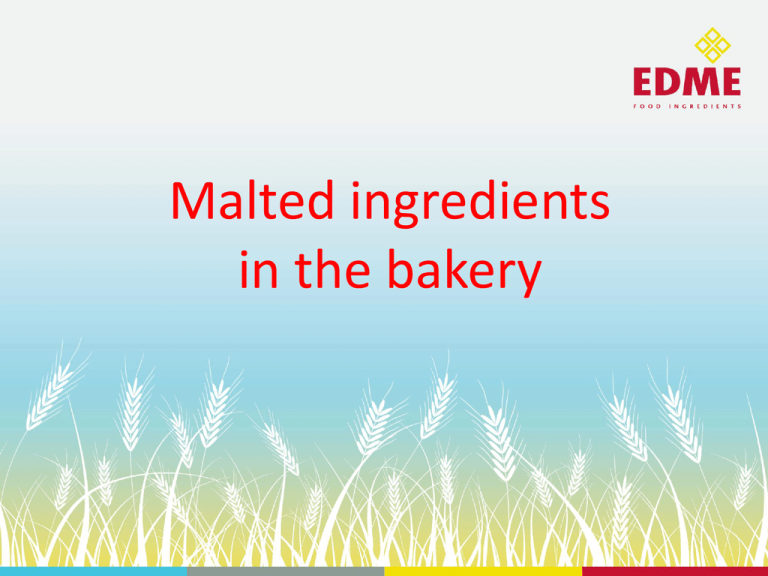
Malted ingredients in the bakery What is malt? Malt is germinated (sprouted) grain Usually barley or wheat, but other grains also malted – Rye, Oats, etc Germination Grain produces high levels of enzymes Some convert the starch in the grain into sugars. Malt’s primary use is in brewing – the sugars are fermented by yeast to produce alcohol. The enzymes and the sugars in malt are very useful in baking……… The malting process Steeping Germinating Kilning Grain is steeped in water to kick-start the biological process of germination. Grain begins to sprout and is then allowed to grow for several days. Once the correct degree of modification has been achieved, the malt is kiln dried to stabilise it for long term storage. Sometimes a roasting process is utilised instead of kilning which can produce very intense flavours and colours. What is malt? Malt in baking…… ‘Diastatic Malt’ is one of the earliest bread improvers and is still used by millers and bakers to improve loaf volume, crust colour and flavour in various bakery applications. ‘Diastatic’ is a term that is used to describe enzyme activity. The primary enzyme responsible for improving bread quality is alpha amylase although a whole range of other enzymes relevant to bread making are also found in malt. Ye Olde Bread Improver Diastatic Malts During fermentation and baking Alpha-amylase attacks damaged starch in the dough, converting exposed starch into sticky sugars (dextrins.) Some starch damage is produced during the flour milling process and the rest occurs by gelatinisation during baking. Other enzymes breakdown dextrins into simple sugars, some are converted into CO₂ during fermentation - loaf volume increase. Some remaining sugars react with proteins to produce Maillard reactions or caramelise during baking - Increase in crust colour and bread flavour. Addition of 0.3% Diastatic active malt flour on left Bagel examples Active Flour @ 0.25% Active Flour @ 0.50% Active Flour @ 0.75% Benefits of Edme enzyme active flours: Increased crust colour and shine Crust – smoother and consistent compared to pitted, wrinkly appearance Increased dough extensibility, improved dough handling Improved flavour profile Bagel examples SF1 @ 0.25% SF1 @ 0.50% SF1 @ 0.75% Crumb structure: • Increase in active flour : • More even cell structure • Finer crumb • Softer texture • Extensibility & handling • Dough relaxing Benefit also applicable in many other bakery applications Wrinkly Pitted Uneven colour No shine Increase Even coloured Consistent deeper colour Smooth surface Shine Bagel examples SF1 @ 0.25% SF1 @ 0.50% SF1 @ 0.75% SF1 @ 0.25% SF1 @ 0.50% SF1 @ 0.75% Diastatic Malts cont… Diastatic malts also contain other useful baking enzymes. Proteolytic activity: Used to increase dough extensibility and reduce shrinkage in pressed doughs such as pizza and others by modifying the gluten network. Amylase from Malt is more heat resistant than fungal amylase and recipe additions must be carefully controlled. Additions of <0.3% on flour weight are typical. Alpha-amylase activity continues to produce dextrins during baking and can create stickiness if used in excess. The sticky texture of the classic British malt loaf is produced by using high levels of diastatic malt flour – up to 15% on flour weight. Non-diastatic Malts Malts for colour, flavour and texture Malt is kilned to stabilise it for storage. Low temperature drying preserves the enzymes created during germination Higher temperatures reduce the enzyme activity and create colour and flavour by Maillard reactions and caramelisation. Malted Ingredients provide flavour and colour to bread, cakes and other baked goods. Colours are described using a brewing method (European Brewing Convention). Colours range from cream (30°EBC) up to almost black (1500°EBC). Addition rates are from 1% to 5% depending on the product and intensity of flavour required. Non-diastatic Malts Malts for colour, flavour and texture Malted grains used for the textural enhancement of baked products and are typically used in conjunction with powdered malts for background flavour. A classic malted brown bread recipe might include malted wheat flakes and a medium coloured malt flour at 17% and 2% respectively on flour weight. As well as being derived from whole grains and high in fibre, malt is also naturally high in antioxidants – a typical malted brown bread can contain more antioxidants than standard white and wholemeal bread. Malt extracts Malt extracts Made by combining milled malt with water and gently heating to accelerate enzyme activity in a process called ‘mashing’. Process converts most of the starch into a sugary solution or ‘wort’. This is then concentrated by evaporation into a viscous syrup - malt extract. Liquid malt extracts are very sweet but not too easy to handle - viscosity. Spray Dried and Band Dried Powders Liquid extracts are also dried to a powder using spray or band dryers They are equally as sweet and easier to handle Dried extracts are hygroscopic - stored away from moisture and humidity. Like other malt, liquid and dry malt extracts can be diastatic and non.
